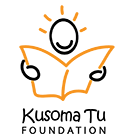I first learnt of Kusoma Tu Trust while working at Haba Haba. We had just launched this amazing learning and revision application – Revision844 and were looking to work with various schools to test the app. The fact that the Kusoma Tu had piloted in a primary school that I had attended got me really excited and I wanted to know even more about it.
Have you ever pictured yourself being in a situation where it’s just a few months to your final exams yet you do not even know how to write your own name? Not being able to read simple 3 lettered words? How then would you be able to read questions, understand them and provide answers in the so called National (final) exam? What value will you have gotten out of primary school with?
Well, as unbelievable as it may sound, there are kids who go through school just as routine. Classes in most government schools are too full (thanks to free primary education and the new rules that no child should stay at home). The teacher pupil ratio in classes is as bad as 1:80 (or even worse). The conditions at home aren’t favourable either – absentee parents for one reason or another.
Here are some questions (with answers) that have helped me get a deeper understanding of the organisation and what it’s doing to help salvage this wanting situation. I hope you get intrigued as I am right now.
Why did you start this organization?
Kusoma Tu Foundation Trust was established in 2009 to respond to the needs of children who were completing primary school and had not learnt how to read. It was established after the realisation that a number of school children were going through and completing primary school without learning how to read. A discussion withe the school administration revealed that a quarter of the children at the school had been labelled as “non-readers”. This phenomenon is not unique to Kawangware Primary School and the research carried out every year by Uwezo hghlights a similar scenario across the country
How has it grown or changed over time? Kusoma Tu Trust began in Kawangware with one volunteer and three books, reading regularly with the children. As time went by, people who heard about us donated books and began to volunteer their time to read with the children. Interest in our work has grown to the extent we have been approached by a number of individuals, organisations and schools to train them on addressing the issues of literacy facing some of the older children in their schools.Last year we began to develop a curriculum and learning materials that address these literacy needs. We hope to develop some training materials for teachers and volunteers working with children who cannot read.We also hope to develop an e-learning version of our materials that can be made available to a wider population both in and out of school.We have received support from a number of organisations including Nairobi Chapel who hold a reading camp every April and August at Kawangware Primary, Braeburn school continue to provide resources like books, a printer and other equipment like the desks and chairs that we use, AIESEC which recently gave us a group of volunteers, The Journey who’s members have taken part in the annual 100km fundraising walk and helped to raise awareness.
Exactly what do you do at Kusoma Tu? We basically teach children how to read, period. Hence the name “Kusoma Tu”. We work with children whose literacy skills are too weak to allow them to have meaningful interaction in the classroom in order to improve their reading and reduce school drop-out rates. Kusoma Tu has developed an innovative reading intervention program to give individualized attention to the children outside the classroom. We begin with an assessment to determine a pupil’s individual challenges, to establish what gaps there are and to identify his or her particular needs. We then design a reading program tailored for each child, based on his or her identified weaknesses. Each child gets an hour daily to help them improve their reading and comprehension skills.We also encourage the children to read books as much as possible to improve their reading and comprehension skills. We have a small library and are working with the school and other organisations to set up a reading room/ library that children can access regularly.
What do you think your beneficiaries would say is the best thing about your organization?
What are your goals for the next three to five years? What priorities will help you achieve them? What barriers are in your way?
Our goals for the next five years include establishing a reading programme in 10 schools in urban informal settlements (both public and complementary schools), establishing functional libraries in 15 schools, training up to 300 teachers who work with children who cannot read and establish a learning centre that focuses on providing support for children with special needs in literacy, and in particular reading disorders like dyslexia.
To achieve these goals, we require a working curriculum and teaching/ learning materials that are user friendly and that can be used by people who are not trained teachers. We also want to develop more links with people who are doing similar work or complementary work.
We hope to raise enough resources to be able to implement all aspects of our programme so as to maximize gains for the children.
We don’t envision any barriers to achieving our goals apart if we will be able to raise the resources we require. Schools and pupils themselves have so far been very responsive to our work.
Images courtesy of Haba Haba
